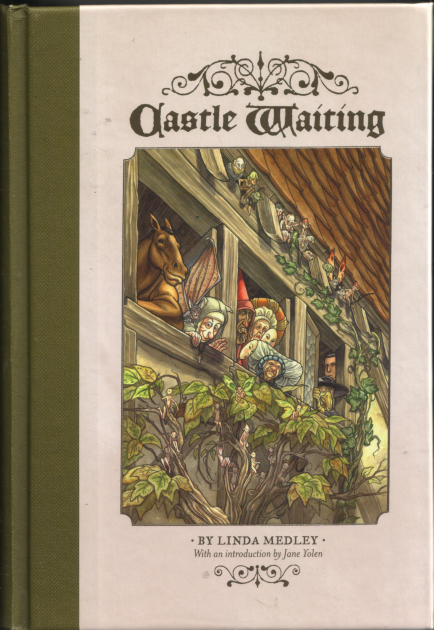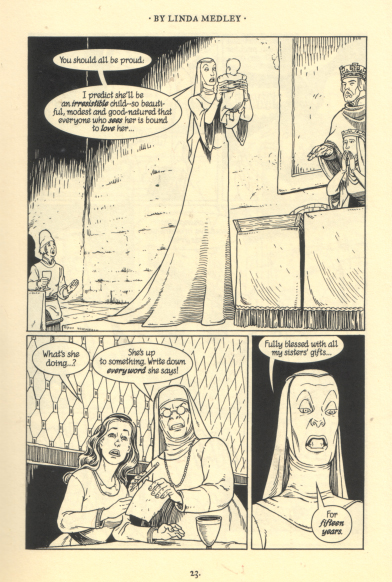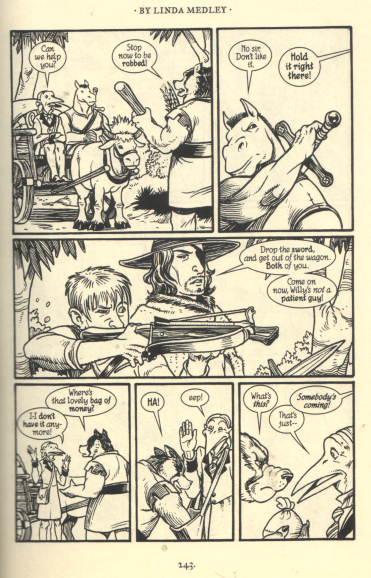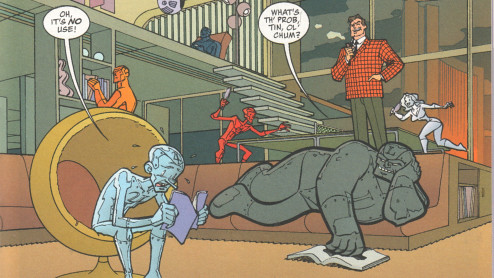
Castle Waiting
Linda Medley
Fantagraphics Books, 2006
Linda Medley
Fantagraphics Books, 2006
A few weeks ago, as I was browsing the graphic books section of my local excellent new-and-used bookstore, I came across an item of which I had heard nothing: a smallish (5.5 x 8 in) hardcover volume by Linda Medley called Castle Waiting. It appeared to be a retelling of the Sleeping Beauty story in beautiful clear-line comics format.

I got lost in the book for a good twenty minutes before being roused by my companion. I didn't pick the book up then, but put it on my buy-list. Not long ago, I was given a copy (along with numerous other Neat Stuff) by a Generous Benefactor, and now, having read the whole book, I can say that it is both more and less than I had anticipated.
The qualities that attracted me to the book in the first place did not disappoint. The art is attractive, with a direct and straightforward storytelling style using beautiful images; the comics equivalent of a Clint Eastwood-directed movie. For the most part, the writing matches the excellence of the art; the dialogue is natural without being anachronistic, the characters are well-realized and consistent, and even the throwaway bits are amusing (such as a background song about Queen Dinah Saurus).
The Sleeping Beauty story turns out just to be the set-up; after introducing all the familiar elements - the curse, the ban on spinning in the Kingdom, the pricked finger, the deep sleep, the barrier of thorns - Castle Waiting dispenses with the rest of the story - the 100-year coma, rescue, and departure of the princess - in about six pages. What the book is really about is the castle itself, which becomes a sort of refuge for a collection of oddball characters unable to fit in with the outside world.
The world in which Medley situates the castle is an odd but beguiling one. It is that sort of vaguely European, vaguely medieval world that is the favorite of many fantasy writers. This particular version is peopled not only with fairy tale types, like Beauty and Ruplestilskin, but with some anthropomorphic animals, as well - usually innkeepers and tradesmen are humans, but sometimes they are cats or bears, with no explanation given. The steward of the castle is a stork and one of the guests is a knight who is a horse - but they ride together in an ox cart.

The end result is a bit jarring at times; since characters hunt and fish, I wonder how they distinguish between people-animals and animal-animals, but maybe that's just me.
Worlds blend in other ways. In an early adventure, the nominal protagonist Jain gets involved with both some Gypsies and what appear to be some Hobbits, and despite the unspecified setting of the story, references are made to Saint Wilgefortis, a historical (although fictional) Catholic martyr from the 15th century. There are also references to characters I feel I should know (or might have known) from other traditions, but I couldn't quite place them.
Most of the time, the "continuity" issues aren't a concern, since the characters are so compelling. Castle Waiting is peopled by men and women and animals (but mostly women) who are intelligent and aware and well-intentioned and flawed and noble and real. There's conflict in the story, but violence is not the solution of first resort, and many problems are solved by reason and creativity rather than fighting (although the horse-knight, Sir Chess, does knock some blackguards around). This book is full of good role models for children, young girls in particular.
As much as I enjoyed the story, which follows the arrival of Jain at the castle, the birth of her child, and her initial interactions with the rest of the residents, I have the same quibble with the book as some other reviewers did: about halfway through, just when the reader is getting comfortable with the characters, one of them begins to tell a story in an extended flashback - which has another extended flashback story in it - for just about the rest of the book. This complete shift away from the cast of characters, who all but disappear except for vignettes setting up the storytelling, is at best confusing and more than a little disappointing. Since the book is a collection of an ongoing series, it might have been a better to break it into two volumes, with a framing sequence for each.
In the end, it's really a rather small problem with the book; Castle Waiting is well worth a place in your collection.



2 comments:
Nice review.
Re: Breaking the book into two volumes
To have all of the story published so far in one single volume was the explicit purpose of this collection, AFAIK. The series has been published on and off between 1996 and 2001 (see wikipedia for a detailed publishing history) and there were some smaller collections before this one, IIRC.
But when Medley recently restarted the series at Fantagraphics (currently at #2) after a hiatus of more than 4 years, it only made sense to collect all of the previously published material to make it easy for new readers to catch up on the backstory (also, all previous issues and collections probably were effectively OOP).
And the drift in storylines should probably not be too surprising, considering the publishing history, but of course it becomes more obvious in a complete collection.
~Althalus
Ah - I can see the strategy behind that, now that you have explained the publishing history. I must say, I had completely missed the ongoing series.
Still, I would like to have seen a division in the book: Book One and Book Two, or something like that, to let the reader know that the "drift" was beginning in earnest.
Post a Comment